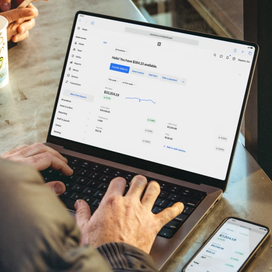Table of contents
Jennifer Segale (owner) and Marie Piña (manager) run Garden Apothecary in Half Moon Bay, CA, a shop, nursery, and farm selling everything from organic teas to skincare to plants. Segale credits her team as the backbone of the business and crucial to its success. However, the Garden Apothecary team initially struggled to find a seamless, trackable approach to staffing and scheduling.
“I had a very small team,” Segale said. “And quite frankly, I couldn’t manage my team before using Square. There was no coherent way of clocking in, clocking out, really keeping track of people’s hours, keeping track of the money in my little shoebox. It was a lot of trust and it was a lot of disorganization. Looking back on it now, there virtually was no management because I just didn’t have the technology or the tools to do so. I didn’t even know that the tools were out there and this is how you could manage people with such a small business. I thought you only had to be a large business and have expensive technology in order to manage employees, create a POS system for customers, and manage your inventory, your payroll, your money.”
After implementing a staffing and scheduling tool in Square Shifts that is easily connected to their POS and Payroll, the operators of Garden Apothecary quickly started to alleviate a lot of those concerns. Here’s how, in their own words:
Note: This business was compensated for its participation.
1. Streamlining operations
Pina: When I started with Garden Apothecary, we were not using Square Shifts and we were using a calendar application and keeping requests on a notepad written down somewhere, or in my notes on my phone, trying to remember all of those special requests and scheduling preferences from the team, and then trying to share that with them through using the calendar application.
We realized once we added more team members that we really had to come up with a better, more streamlined process. And we looked at a couple of other applications out there, but we liked that we could integrate the schedule in with what we were already using for the business. So we were already using it for our POS, we were already using it for inventory, and it was an application that the team was already familiar with and already had on their phone, so it just made sense for us to utilize it that way. It had a lot of features that some of the other applications that we looked at didn’t have.
For me it’s just really easy to be able to go into one application and process everything there, so I’m able to make the schedule, I’m able to review the hours, I’m able to look at my labor versus my sales report, I’m able to run my payroll, I can go in and make adjustments. I’m able to track sick time or vacation time. I have one other employee who is salaried and I’m able to monitor his hours and make adjustments if he’s taken some time off or doing something like that.
2. Ease of use for employees and managers
Pina: If the associates choose, they can get a reminder on their phone notifying them of an upcoming shift, and that way we don’t have to rely on them remembering their schedule or having that in their own personal calendar. They get a reminder of their shift, they’re able to choose the location that they’re working at for that current day. We have two separate locations at Garden Apothecary and Square allows the associates to easily toggle between locations.
We flex people, sometimes throughout the day, sometimes throughout the week. They’re able to clock out for lunch breaks, clock back in after lunch break, and occasionally there’s a mistake made and they’re also able to request an adjustment to their clock in/clock out. Through Square, I get a notification, or an email, whatever I choose, to go in and I can approve that change or I can propose a different adjustment to their schedule.
3. Reducing time costs and increasing efficiency
Pina: On a weekly and more longer-term basis, it’s also really nice because we tend to have the same shifts worked each week, and I’m able to easily copy and duplicate that schedule into the following week., If I do have instances where someone requests off, or someone is ill, it’s easy for me to have that saved in the calendar, they can submit the request, I approve it at any time. Square Shifts saves that information for me, so I don’t have to rely on my own memory to know when someone’s going out of town for the weekend — it’s there as a reminder for me so I know to schedule someone else on that shift.
And then also, if there’s a shift that I don’t have coverage for, I’m able to create an open shift and my entire team is able to see that on their app and they’re able to request it or they’re able to send me a message if they can work a portion of that shift. I can separate it out, switch people around, color code certain shifts based on the location or if they’re working at the farm as opposed to one of our retail locations. And I can put notes in each shift as well. Something like, “Please plan to take your lunch early today because we have an appointment at 2:00 p.m.”
Given the seasonality of our business, everything is focused on what’s being harvested and what’s ready to bring into the shop. Being able to duplicate my schedule from week to week and just make adjustments based on employee availability and things that pop up has been hugely time saving.
Segale: I used to have to drive home or end my day early to sit at a desk and go through a stack of paper and figure out what payroll is. And that’s just not how it is anymore. There’s a lot more autonomy. My employees have a bigger role because they’re kind of empowered with their own Square App of clocking in and clocking out. And so the security is there. And just the feeling that I know things are really buttoned up and thorough. I can double-check them and I can do it in a way that is really efficient, that feels good to pay payroll every two weeks.
4. Increased transparency
Pina: I know that the team also likes that they can see who else is working and where, and that helps guide and direct their communication on our communication app so that they can reach out to the right people, they know who’s working, they know when they’re coming in, and they can opt to switch shifts if they need to.
5. Avoiding inaccuracies
Pina: I have had employees use Square Shifts, the mobile application on their phone, to double-check their hours. And I ask everyone to look at their hours at the end of their shift and then also to look at their hours each Sunday evening, because I typically try to process payroll on the following Monday morning before everyone’s getting paid, and that’s where they tend to find the issues if they have made a mistake clocking in or out, or if they’ve forgotten to clock out. And I appreciate that Square Shifts automatically clocks someone out after 24 hours. I’ve used other applications that don’t and it gets really messy and convoluted when you’re trying to back that up and correct it.
Typically I will use Square Shifts to audit shifts in the moment, when I know that there’s been a mistake made. Someone might reach out and say, “I forgot to clock in this morning,” and I’m able to go and do that in the moment. But I’m also using Square Shifts on kind of a scheduled weekly base basis, where Monday mornings I will go through and I’ll just do one more review of the entire week, and that’s just kind of like a double-check on myself to make sure that when I’m pulling my sales versus labor report right after, that that information is accurate. So I want to make sure that all of the shifts are put in correctly before I’m pulling my other reports.
Get started with Square Shifts here.
![]()












